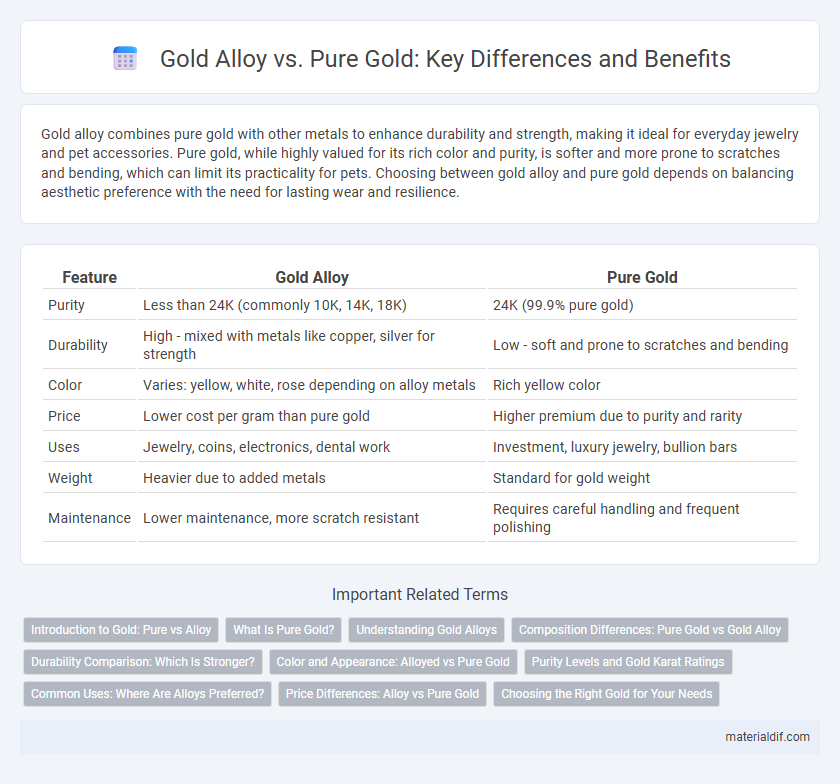Gold alloy combines pure gold with other metals to enhance durability and strength, making it ideal for everyday jewelry and pet accessories. Pure gold, while highly valued for its rich color and purity, is softer and more prone to scratches and bending, which can limit its practicality for pets. Choosing between gold alloy and pure gold depends on balancing aesthetic preference with the need for lasting wear and resilience.
Table of Comparison
| Feature | Gold Alloy | Pure Gold |
|---|---|---|
| Purity | Less than 24K (commonly 10K, 14K, 18K) | 24K (99.9% pure gold) |
| Durability | High - mixed with metals like copper, silver for strength | Low - soft and prone to scratches and bending |
| Color | Varies: yellow, white, rose depending on alloy metals | Rich yellow color |
| Price | Lower cost per gram than pure gold | Higher premium due to purity and rarity |
| Uses | Jewelry, coins, electronics, dental work | Investment, luxury jewelry, bullion bars |
| Weight | Heavier due to added metals | Standard for gold weight |
| Maintenance | Lower maintenance, more scratch resistant | Requires careful handling and frequent polishing |
Introduction to Gold: Pure vs Alloy
Gold alloys combine pure gold with metals like copper, silver, or zinc to enhance durability and alter color, while pure gold, known as 24-karat gold, offers maximum purity but remains soft and malleable. Common karat ratings such as 18K, 14K, and 10K indicate the proportion of gold mixed with other metals, impacting hardness and price. Understanding the balance between purity and strength helps determine suitability for jewelry, investment, or industrial applications.
What Is Pure Gold?
Pure gold, also known as 24-karat gold, consists of 99.9% gold with no other metals mixed, making it highly malleable and soft. Its bright yellow luster and resistance to tarnish make it ideal for investment and high-quality jewelry, though its softness limits practical everyday wear. In contrast, gold alloys combine pure gold with metals like copper or silver to enhance durability and alter color, catering to more functional uses.
Understanding Gold Alloys
Gold alloys combine pure gold with metals like copper, silver, or zinc to enhance durability and alter color, making them ideal for jewelry and industrial use. Pure gold, measured at 24 karats, is too soft for most practical applications, so alloys improve hardness and resistance to scratches. Understanding the specific alloy composition and karat value helps determine the balance between purity, strength, and color characteristics.
Composition Differences: Pure Gold vs Gold Alloy
Pure gold consists of 99.9% gold with minimal impurities, making it soft and malleable, while gold alloys combine gold with metals such as copper, silver, or zinc to enhance durability and alter color. The karat system quantifies purity, with 24-karat representing nearly pure gold and lower karats indicating higher alloy content. These compositional differences affect gold's hardness, color variations, and suitability for various jewelry and industrial applications.
Durability Comparison: Which Is Stronger?
Gold alloys, composed of gold mixed with metals like copper, silver, or zinc, exhibit significantly higher durability compared to pure gold, which is naturally soft and prone to scratching and bending. Pure gold, typically 24 karats, lacks the strength needed for everyday wear, making 14k or 18k gold alloys a preferred choice for jewelry due to their enhanced hardness and resistance to deformation. Alloys balance aesthetic appeal with practical strength, with 14k gold offering the toughest composition without sacrificing intense gold color.
Color and Appearance: Alloyed vs Pure Gold
Gold alloys contain a mixture of pure gold and other metals, which alters their color and enhances durability compared to pure gold's rich yellow hue. Pure gold (24K) exhibits a bright, warm yellow tone, while alloys such as rose gold or white gold result from blending gold with copper, silver, or palladium, creating distinct pinkish or silvery shades. The variety of colors in gold alloys provides more options for jewelry design while maintaining an attractive appearance that differs from the uniform color of pure gold.
Purity Levels and Gold Karat Ratings
Gold alloys combine pure gold with metals like copper, silver, or zinc to enhance durability, with purity levels measured in karats indicating the proportion of gold per 24 parts. Pure gold, known as 24 karat, contains 99.9% gold but lacks strength, making lower karat alloys such as 18K (75% gold) and 14K (58.3% gold) more practical for jewelry and everyday use. Understanding gold karat ratings is essential for evaluating the balance between purity, durability, and value in gold products.
Common Uses: Where Are Alloys Preferred?
Gold alloys are preferred in jewelry making, especially for daily wear items like rings and bracelets, due to their enhanced durability and resistance to scratching compared to pure gold. Alloys are commonly used in electronics and dental applications, where the added metals improve strength and conductivity. Pure gold, with its softness and high malleability, is less suitable for such practical uses, making alloys the dominant choice in both industrial and ornamental contexts.
Price Differences: Alloy vs Pure Gold
Gold alloys typically cost less than pure gold due to the presence of other metals like copper, silver, or zinc, which reduce the overall gold content and market value. Pure gold, also known as 24-karat gold, commands a higher price per gram because of its rarity and higher gold purity. The price disparity between gold alloy and pure gold is influenced by factors such as purity level, manufacturing process, and market demand for different karat ratings.
Choosing the Right Gold for Your Needs
Gold alloys offer enhanced durability and resistance to scratching compared to pure gold, making them ideal for everyday jewelry and items requiring strength. Pure gold, typically 24 karats, provides unmatched purity and a rich yellow hue but is softer and more prone to damage. Selecting between gold alloy and pure gold depends on balancing aesthetics, durability requirements, and budget considerations for your specific use.
Gold Alloy vs Pure Gold Infographic

 materialdif.com
materialdif.com